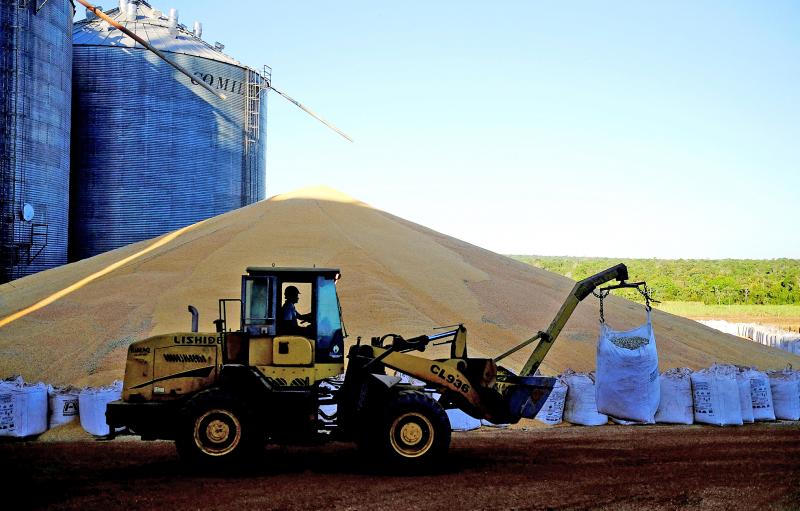Corn is stacking up outside of Brazilian silos at the fastest rate in years as the country’s biggest-producing region harvests a bumper crop.
Warehouses are still full of soybeans, which are reaped only a few months before the corn. In Mato Grosso, soy production was also huge this season and sales have been slower than usual, leaving the warehouses with no room to receive the corn, said Cleiton Gauer, superintendent at IMEA, Mato Grosso’s rural economy institute.
While it is not unusual for crops to be stored in the open when indoor capacity fills up, it has not been seen at such a scale for at least the past two years.

Photo: Reuters
However, as Mato Grosso’s huge corn harvest gets pace, farmers and traders have been especially short of room.
The pileup threatens to add further pressure to corn and soy prices that are already slumping in Chicago futures markets amid promising weather in the US growing areas.
Corn Thursday sank on to the lowest level since before Russia invaded Ukraine, while soybeans touched the lowest level since January with edible oil supply picking up and a broader commodities malaise.
The slide in crop futures offers a glimmer of optimism that food inflation might be tempered in coming months, even as prices remain historically high.
At the end of last month, about 9.9 million tonnes of soybeans in the state were still on farmers’ hands, compared with 4.9 million tonnes a year earlier, said Daniele Siqueira, an analyst at AgRural consultancy firm.
This month, soy sales have accelerated on a weaker real, improving demand and the pressure to get the oilseed out of the bins, she said.
Another reason for the lack of room is how fast the harvest is happening in Mato Grosso. On Friday last week, reaping was 27 percent complete, compared with 4 percent a year earlier and the five-year average of 14 percent, Imea said.
RUSSIAN GOLD
Swiss customs officials are looking into the import of 3.1 tonnes of Russian gold last month to see whether the deals via the UK might have violated sanctions imposed on Russians over Moscow’s invasion of Ukraine, the Swiss government said on Friday.
Customs data on Tuesday showed Switzerland imported about US$200 million worth of gold from Russia last month, the first imports since the Kremlin sent troops into Ukraine in February.
Switzerland is one of the world’s biggest refining and transit centers for gold, and Russia is one of the biggest bullion producers.
The Swiss Federal Office of Customs and Border Security said in a statement that it could not for legal reasons say who imported the gold of Russian origin from the UK.
“Around three tons of gold originating in Russia and worth CHF194 million [US$202 million] were imported from the United Kingdom to Switzerland. The BAZG [Federal Office of Customs and Border Security] is checking the affected imports with regard to the applicable sanctions,” the BAZG said in a statement posted on the government’s Web site.
Switzerland has adopted practically all EUsanctions against Russian companies and individuals.
Importing Russian gold to Switzerland is not prohibited, but the export of gold to Russia is banned.
All bars produced by Russian refineries after March 7 may no longer be traded in Switzerland.
However, in principle, bars produced by Russian refineries before March 7 can continue to be traded, the office said.
Gold for August delivery on Friday rose US$0.50 to US$1,830.30 an ounce, down 0.6 percent for the week.
Silver for July delivery on Friday rose US$0.08 to US$21.13 an ounce, down 2 percent weekly, and July copper was unchanged at US$3.74 a pound, down 6.7 percent for the week.
Additional reporting by Reuters and AP
Comments will be moderated. Keep comments relevant to the article. Remarks containing abusive and obscene language, personal attacks of any kind or promotion will be removed and the user banned. Final decision will be at the discretion of the Taipei Times.

